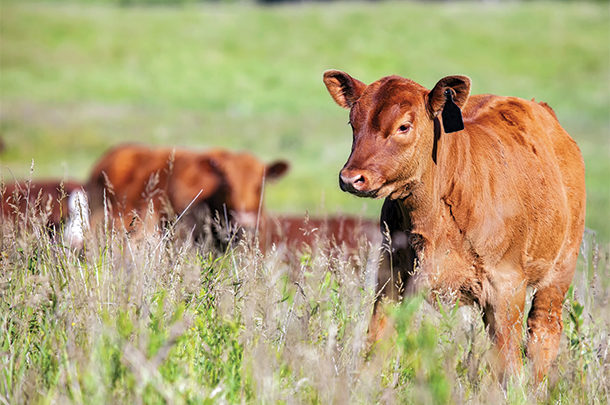As weather begins to warm, it is easy to think you’re out of the woods from the health risks spurred by the cold, winter months – but not so fast there, friends.
“During springtime, it’s important for cattle producers to gear up for warm weather risks calves are up against, like summer pneumonia and pinkeye. These costly conditions can be well avoided through sound management and prevention methods,” says Arnold Nagely, DVM, co-founder of Valley Vet Supply. Dr. Nagely practiced food animal veterinary medicine for 27 years before founding Valley Vet Supply, alongside fellow veterinarian Ray Shultz.
Summer pneumonia
Also referred to as pasture pneumonia, summer pneumonia is best described as a respiratory disease affecting younger calves on pasture, usually late in the summer. The infectious agents associated with summer calf pneumonia mirror those causing typical post-weaning bovine respiratory disease (BRD), such as Mannheimia haemolytica, Histophilus somni, Pasteurella multocida, infectious bovine rhinotracheitis virus (IBR) and bovine respiratory syncytial virus (BRSV).
Transmission
The risk for summer pneumonia-causing viruses and bacteria can increase as temperatures change or during times of greater stress, such as processing or transporting calves. Vaccination programs, combined with sound herd management, are key for prevention.
“I’ve always thought of summer pneumonia being related to the antibody levels from the colostrum dropping below protective levels, usually when the calf is 3 months or so old,” says Shultz. By ingesting quality colostrum, calves absorb maternal antibodies that initiate a strong immune system early in life; however, this immunity deteriorates as the calf gets older, making vaccinations vital. Vaccines sensitize and train the calf’s immune system to recognize and fight these viruses and bacteria when encountered.
“Summer pneumonia often coincides with the farmer stockmen being very busy with hay and other crops, so they are unable to watch calves as closely. This can make summer pneumonia seem like a sudden disaster because the first thing they may see is a severely sick or even a dead calf,” continued Shultz.
Signs
- Droopy ears
- Sluggish demeanor
- Extended neck
- Rapid breathing
- Nasal discharge
Prevention
To help prevent summer pneumonia risk, “Vaccinate calves prior to sending to pasture with a modified-live virus vaccine combined with pasteurella pneumonia,” encourages Shultz.
“Timely vaccine utilization is crucial to help prevent summer pneumonia,” Nagely says. “In addition to vaccinations, incorporate an injectable, aqueous supplemental source of zinc, copper, selenium and manganese in the cows and calves to help optimize immunity. Trace minerals are important for immunity and immune response to vaccines.”
Pinkeye
 Tall grass in pasture should be monitored, trimmed or consumed, since it poses a pinkeye risk from eye injury to cows and calves. Photo by Lynn Jaynes.
Tall grass in pasture should be monitored, trimmed or consumed, since it poses a pinkeye risk from eye injury to cows and calves. Photo by Lynn Jaynes.As spring turns to summer, conditions also become ideal for the development and transmission of Moraxella bovis, the primary infectious agent of infectious bovine keratoconjunctivitis (IBK), more commonly known as pinkeye. Pinkeye is a highly contagious ocular disease primarily affecting calves and can lead to vision loss. Pinkeye in calves and younger cattle is more common because they have not yet developed immunity to Moraxella bovis.
In addition to the pinkeye-causing bacterium Moraxella bovis, other sources of eye irritation can result from tall grasses rubbing the eyes as cattle walk and graze, as well as dust particles and other debris impacting the eye.
Transmission
Pinkeye is spread when an animal comes into contact with infected secretions of another.
“While moraxella bacteria are responsible for the pinkeye infection, face flies are known to transmit the bacteria from animal to animal,” Nagely says. “As the weather warms in the spring and temperatures go up, so do the fly populations. Pinkeye can quickly escalate to be the biggest challenge for cow-calf herds during late spring and summer.”
Face flies feed on eye and nose secretions, carrying infectious agents with them. Flies can harbor Moraxella bovis for up to three days, transmitting it rapidly from infected to non-infected animals. This condition can plummet profit by as much as $12 per hundredweight compared to healthy calves sold without pinkeye, according to data provided by Bayer Animal Health.
Signs
- Mild eye irritation with tears
- Ulceration of the cornea
- Severe inflammation
- Vision loss
- Elevated body temperature
- Decreased time spent grazing
- Suppressed appetite, from pain
- Loss of weight and body condition
- Increased time in the shade
Prevention
“With the timely use of newer vaccines and utilizing other control steps, many producers have been able to change a dreaded annual pinkeye debacle into an experience of a rare pinkeye incidence. The savings in time, cost of treatment combined with production loss, can be immense,” says Nagely.
Because Moraxella bovis transmission often involves face flies, an intensive fly control program is essential, among other best management practices. Several steps can be taken to greatly reduce the likelihood of pinkeye infection, including:
- Timely pinkeye cattle vaccines; your veterinarian or medical professionals can help discuss sensible options
- Clipping tall grass heads in pastures to avoid scratching the cattle’s eyes
- Minimizing the level of dust in hay and feedbunks to avoid eye irritation
- Ensuring cattle have ample shade
- Implementing fly control methods, such as:
o Fly tags, an economical aid in the control of face flies for up to five months
o Cattle rubs charged with insecticide or dust bags, allowing cattle to frequently self-treat
o Pour-on insecticides, if more frequent application is feasible, as well as practicing insecticide rotation
o ATV insecticide mist sprayers, CO2 veterinary gun capsules and pump-up sprayers, for speed and convenience
o Insect growth regulator (IGR) feed-through larvicide mixed into mineral to prohibit immature flies from developing into adults
“When comparing fly control methods, consider what is the most practical to implement in your operation,” encourages Shultz. “If your herd interaction is infrequent due to time, distance or pasture size, your approach may differ from a producer whose cattle are nearby and easily accessible.”
Help safeguard your herd’s health by taking steps to protect against common health conditions like summer pneumonia and pinkeye. Go to valleyvet.com or speak with a veterinarian to learn more.











